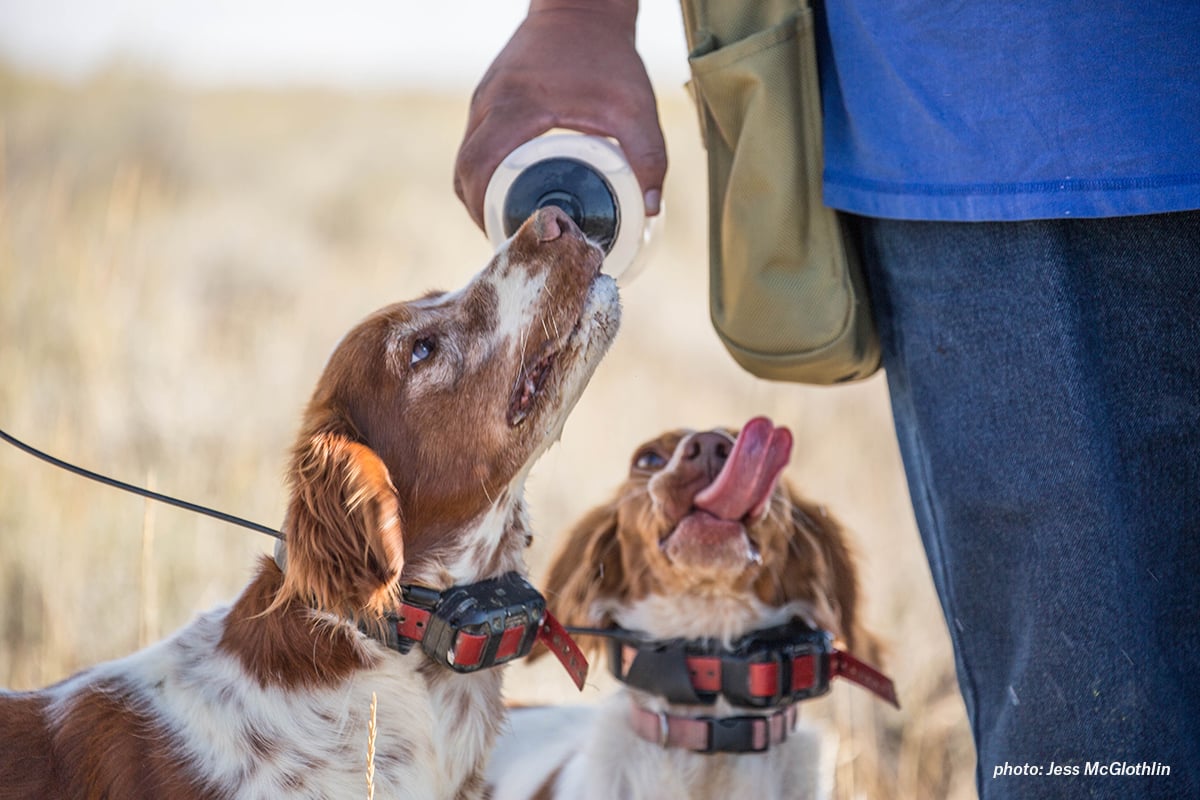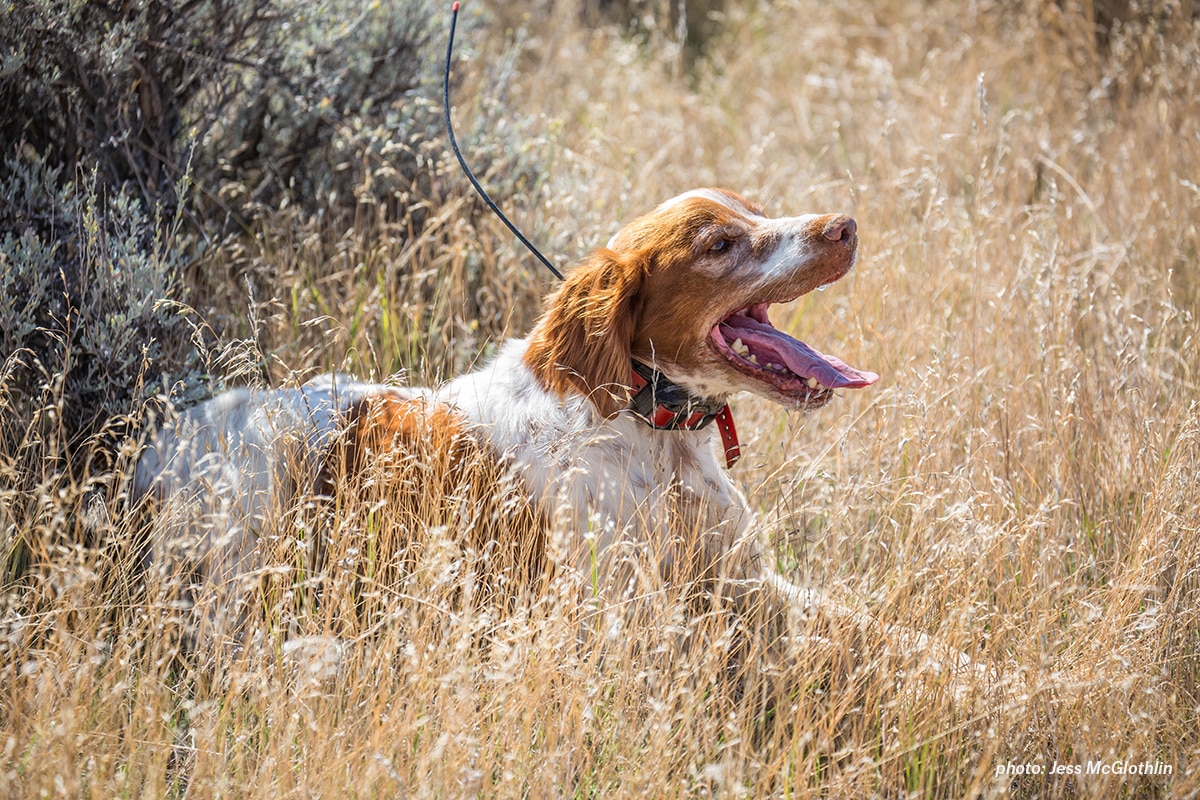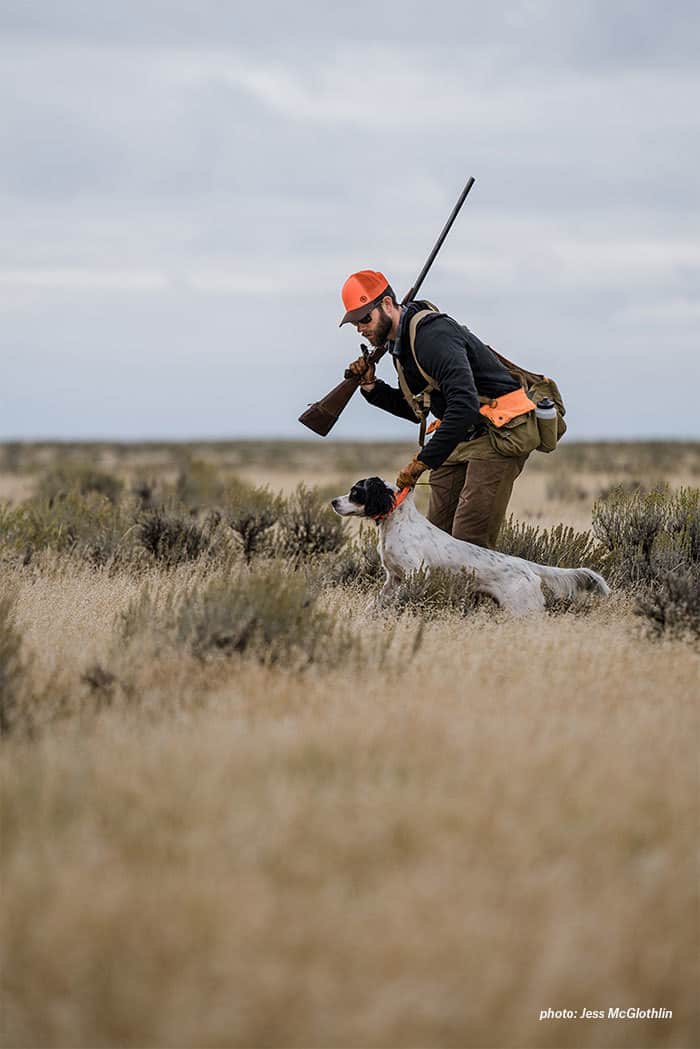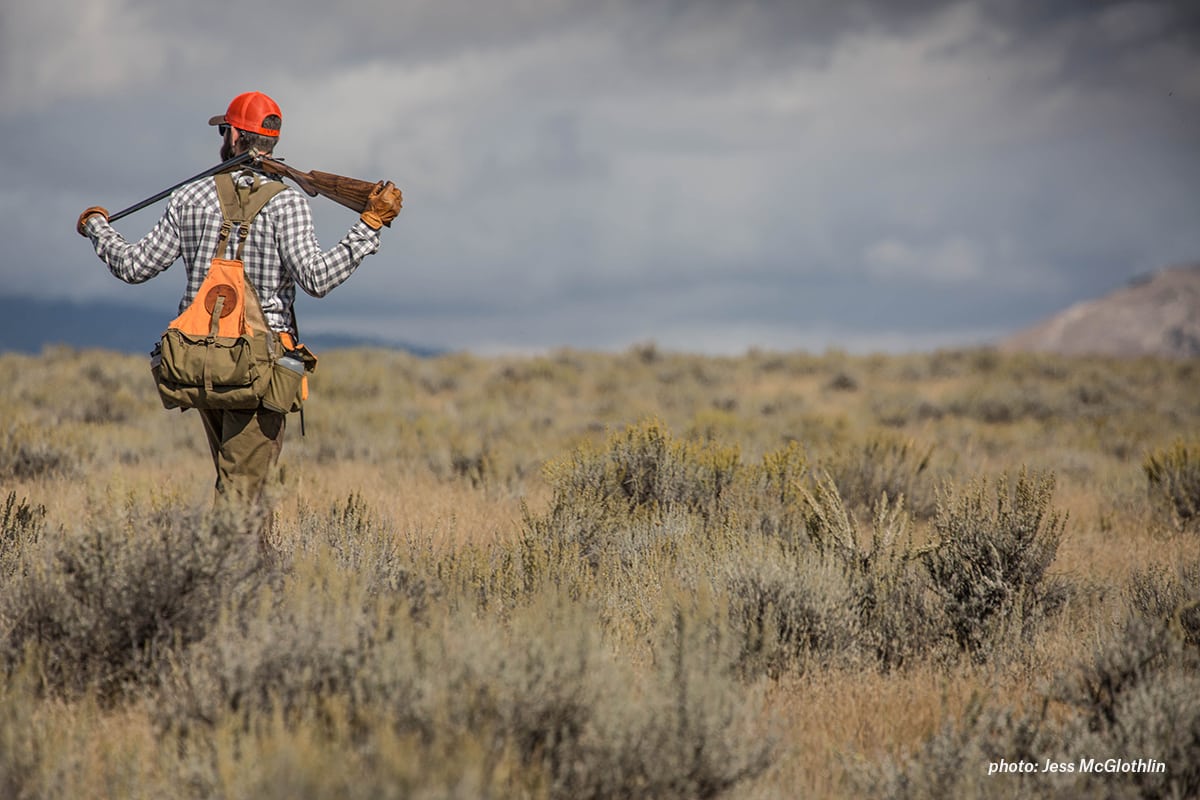With a little help from onX Ambassador Brandon Moss and Shawn Wayment, DVM, we discuss preseason canine conditioning as well as emergency field care and preparation.
For those of us that run bird dogs, the summer months are a time for excited anticipation on our end and preparatory training and conditioning for the dogs. When we turn them loose in the fall, our success will depend on the work we’ve put in prior to the season. In addition to the training, we need to be prepared for the moments when things go wrong in the field and our dogs require medical attention. They don’t happen often, but being prepared for these moments can mean the difference between a lost afternoon of hunting and something much worse.
To help address the issues of preseason canine conditioning and emergency field care, we reached out to a few of our friends. The first is onX Ambassador Brandon Moss (@upland406). Below, Brandon takes you through his summer conditioning routine and a few tips for field care.
The second piece you’ll find below was written by Shawn Wayment, a veterinarian in Colorado who specializes in working dogs. Shawn is widely recognized as a leading resource for bird dog owners and the concerns they face when running dogs in the field. He goes by @birddogdoc on Instagram, and, along with his brother, Andy, runs Upland Ways, an upland hunting blog with a literary bent. In Shawn’s piece, you’ll learn some basics of field care as well as how to decide when it is time to get your dog to the nearest vet.
Following the advice listed below will take minimal effort on your part and could save your dog’s life if something goes wrong. You owe it to your dogs to be prepared for the common injuries and environmental challenges they face—it’s that simple.

. . .
“Bird Dog Conditioning and Field Care” by Brandon Moss
To many of us, our four-legged hunting companion becomes part of our family. When we take them out in the field and turn them loose, there’s no telling what might happen. More often than not, everything turns out for the best. But being observant of your dog and prepared for what could happen is always the best approach.
There are many things that can happen to a bird dog in the field. Snakes, cuts, porcupines, and pulled muscles are just a few examples of what could go astray when bird hunting. It seems like in the last few years, I have been hearing of more and more odd things happening to dogs. In one case, a good friend lost his dog when he was impaled by the branch of a tree—a tragic event no one should ever have to experience.
Oftentimes, I become complacent in areas I hunt a lot. There, I know the risks and the chances of something bad happening. It’s when visiting areas for the first time, though, that my guard goes up.
When hunting a new area, it is important to find out what risk factors lie ahead. Some areas might have a high population of porcupines, and a high probability they’ll be in most upland areas. Having the necessary equipment to handle this situation could be the difference between going to the vet and being able to handle it yourself.
Some people might say they always go to the veterinarian to have the quills pulled, but this is a task I have been able to handle on my own. When it comes to snakebites, the day is over. Immediately, it’s time to head to the nearest vet.
One of the most important tools a person can take with them in the field is a pair of needle-nose pliers or a multi-tool. Cactus in the paws can be impossible to pull out without these tools. I like to have a couple tools in my vest just in case one gets lost or if two people want to work on one dog when a porcupine situation occurs.

In addition to the environmental risks, you also must be aware of the physical well-being of your dog. Sore or worn-out pads, overheating, old joints and pulled muscles can sneak up on a dog quickly. The risk of these things happening can be reduced with proper exercise. Dogs are much like humans—you would never go to a new area without first preparing yourself.
I like to start off my exercise program a couple months before the season starts. Typically, I will run a dog shorter distances every other day for a couple weeks. Gradually, I will lengthen the distance and time we are out.
After a couple weeks, I change it up and will run them consecutive days in a row. We’ll do two and three days in a row at the longer distance. Once the season starts, I will hunt them more days in a row as needed. I truly think the only way to get a dog ready for multiple all-day hunts is by hunting them. Exercise does not take away all risks of these dangers, but it helps reduce them.
Usually preseason exercise programs take place in the summer. I try and get my dogs out in the early morning hours before the heat starts to get to them. As the summer goes on, I make sure they finish working at a temperature close to what they will be hunting in.
Overheating a dog is a risk many people don’t think too much about. I like to find my dogs water they can wade and lie in. ALWAYS carry water for your dog with you.
My rule of thumb, as is the case for many hunters and trainers, is that the dogs come first. They are watered first and fed first—their well-being comes before mine and the hunt. Having a healthy, happy dog is the best way to enjoy your hunting season.
. . .
“Perils and Pearls of Bird Dogs” by Shawn Wayment, DVM
My flashy orange and white setter, prodigy of the great bird-dog-hall-of-famer Tomoka, cruised gracefully across the sage and aspen-covered slope, her feathered tail tickling the mild breeze at 8,ooo feet above sea level. It was glorious September 1st, and the opening of Colorado’s dusky grouse season. Heck, they’ll always be just blue grouse to me—darn lumper and splitter taxonomists! I digress.
Ginny Girl slammed into a breathtaking point in the sagebrush—the kind that sends goosebumps from your head to your trigger finger—while I frantically fumbled for my camera in the breast-pocket of my favorite Orvis grouse shirt. Five grouse flushed sporadically out of the sage and sped to the aspens below. I snapped a photograph of my coverdog holding staunchly on point and somehow managed to drop the last departing member with my Damascus-barreled Parker GH 16ga. on the coveted 0 frame.
My downed bird landed in the hemlock-choked creek bottom, which Ginny Girl delved into to make the retrieve. She returned with the grouse, ears covered with cockle-burs, and hemorrhaging profusely from a V-shaped laceration on her left thoracic limb that cut deep into the cephalic vein. The wound looked typical for the barbed-wire that frequents the open ranges of Colorado’s public lands. Damned barbed-wire!
Gut-wrenching panic started to swell in my belly as I quickly took a deep breath. Relax! I leashed Ginny Girl and headed back to the Tacoma to fetch my field supplies. Immediately upon arrival at the truck, I placed a pressure wrap on the wound to control the bleeding. I placed her in the dog box while I gathered my supplies to suture the wound.
Long story short, while suturing Ginny Girl in the bed of my pickup, a Colorado Parks and Wildlife officer pulled up and observed my undertaking with deafening silence. Finally, after what seemed like an eternity, he broke the tranquility of the Colorado grouse woods, saying, “you’ve got to be a vet.” And, of course, when I was finished, he checked my hunting license. True story.

My daily veterinary practice is limited to bird dog owners and their beloved companions. I spend my entire workday talking about bird dogs and their perils while in the field. The very best advice that I can give bird dog owners is to have a good first aid kit and to know where the nearest veterinarian is from where they’ll be hunting or trialing. The onX Hunt App offers us the ability to drop a Waypoint at any location in the USA, so why not mark the nearest vet clinic in the area you are hunting? This can save you time in case of an emergency. I also suggest that dog owners have Animal Poison Control’s number programmed into their cell phone just in case their dog ingests something harmful—(888) 426-4435.
Please know your limitations in emergency dog care, because any prolonged attempt for treatment in the field can delay the valuable time it takes to get to the nearest veterinary clinic. Use your best judgment and always err on the side of your dog’s best interest. Have wounds checked as soon as you can by your veterinarian.
With that said, there are many things that you, as a bird dog owner, can do in the field to help your dog if it is injured. The most common injuries that I’ve seen can be corrected, or at least reduced in severity, by the owner in the field. For example, these injuries include a number of things like minor lacerations and abrasions, porcupine quills, grass awns or weed seeds in the eyes; spear grass, grass awns, or cockleburs in the coat; pad or foot injuries, exposure to weather extremes, traps and snares, tick and other bug bites and finally known toxins or poison exposures. Lacerations are the most common injury that I see in field dogs. Everything in their world pokes, jabs, or stabs their skin. The most important thing is for you to control bleeding. I carry loads of bulky bandage material in my first aid kit, but a bird dog owner can control hemorrhage with towels or shirts and duct tape. Apply direct pressure to the wound and wrap it tightly with duct tape (duct tape should obviously only be applied temporarily until you can get the dog to a vet).
Minor skin lacerations or tears that aren’t deep into the muscle layers can be cleaned with ½ strength hydrogen peroxide and water or ½ strength betadine solution and water, and then stapled. If the laceration extends into the deeper muscle layers, the muscle layers must be sutured as well. I have taught several of my clients over the years how to suture the subcutaneous layers. It’s not incorrect to cleanse the wound and then staple the skin even if the muscle layers below are lacerated—the skin is a great bandage to protect further debris from collecting in the wound before you can get to your veterinarian for further care.

Always check your bird dogs’ eyes after running them. It only takes a few seconds. The most common thing I see is weed seeds or debris that gets lodged underneath the nictitans or 3rd eyelid. It’s very easy to learn how to look underneath the 3rd eyelid. Rinse the eyes out generously with saline solution from the inside or the middle of the eye outward. The way I look under the 3rd eyelid is to stand the dog on the tailgate, gently push the dog’s eyeball inward, which raises the 3rd eyelid, and then take a cotton tip applicator and roll the 3rd eyelid outward—It’s easy. I once walked a dog owner through this process on Instagram messaging, and he was able to remove the pesky seed.
I carry hydrogen peroxide in my first aid kit, not for cleaning wounds but for causing a dog to vomit if needed. The most important emergency measure in a dog exposed to an oral toxin is to decontaminate them immediately. I’ve had to do this to all three of my bird dogs in the field at one time or another, including when one of them came back with a block of rat bait in his mouth. I feed them a cup of food and then give a tablespoon of peroxide and wait five minutes. If nothing happens, I repeat the tablespoon again and then wait and repeat as necessary. Though the aftermath is not pleasant, it always works.
God made bird dogs tough, so they don’t know when to quit—sometimes only after it’s too late. If it’s hot outside or extremely cold, be your bird dogs’ protector and shield them from the elements. Learn how to open the common snares or traps that trappers use before your dog steps into one. I carry a set of heavy-duty wire cutters in my hunting vest while hunting the grasslands because of local trappers who have equal rights to use public lands .I only disturb their traps if it is necessary to protect my dogs. There are also some great tick preventives out there nowadays so make sure to discuss this with your veterinarian.
Finally, the very best advice I can give bird dog owners is to use common sense while you’re in the field. Find a local veterinarian that truly understands the perils of your bird dogs in the field and ask them to help you learn emergency first aid and set up a first aid kit. Our bird dogs are our pearls afield, so treat them that way.